Turn A Gundam
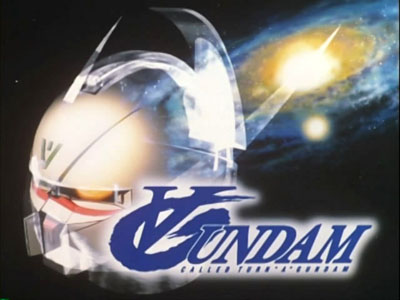
OMG it’s three dee
I find it infinitely difficult to quantify Turn A Gundam (∀ Gundam) as a narrative. After watching it on and off over the course of a few years, I finally finished all fifty episodes this week. This is probably the longest I’ve ever taken to finish a show of any length, a dubious record usually held by titles I deemed to be mostly unfit for consumption. And yet having watched most of what the Gundam metaseries has to offer, I have to say in retrospect that, in spite of all its glaring flaws, Turn A Gundam offers a special ineffable something that lands the title a spot in my heart.
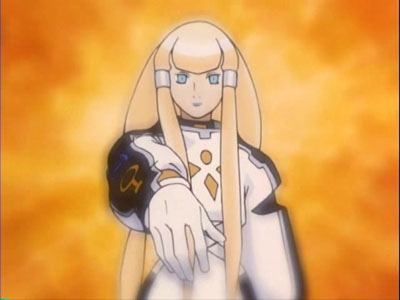
The lunar sovereign
It is my personal opinion that Gundam titles directed by Yoshiyuki Tomino all have poor storytelling. The themes are insightful, the ideas are grand and the creative visions are commendable, but the delivery is consistently awful as Tomino simply lacks the attention to details needed to synergize all those great concepts into coherent narratives. Every major titles directed by him (79, Zeta, ZZ, the semi-aborted F91, Victory) suffers from the same half-baked storytelling that overlooks character-level consistency in favour of big-picture ideas.
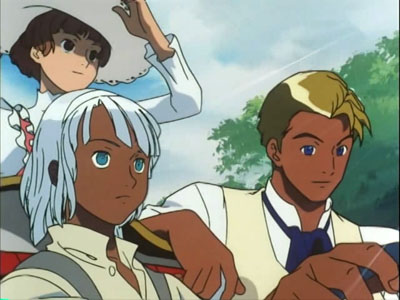
Loran (left) was originally conceived as a girl
Comparing his works to the mini series (80, 83, 08th) directed by various other individuals over the same time frame, a clear distinction emerges between the two groups of Gundam titles in terms of storytelling and attentions to plot details such as character motivations.
Characters in Tomino’s works often assume illogical out-of-character positions for no apparent reason beyond creating plot tension, while characters in other works behave within parameters one can empathize with. Underlying themes in Tomino’s works tend to be more visionary and abstract while the shorter works focus on the wartime human condition within limited contexts. Turn A Gundam is, as I see it, an attempt by Tomino to combine these two distinct aspects of the franchise. I won’t say that he succeeded completely, but I do like the final result.

The series describes an Earth that has recovered from a past global catastrophe and has a thriving industrial human population that is technologically equivalent to the turn of the 20th century. A highly advanced human civilization exists on the Earth’s moon, descendants of past refugees from a devastated Earth. Loran Cehack, the protagonist, is a member of an advance team sent to Earth to live among the local population in preparation for the moonrace’s return to their ancestral home.

As anyone with a slight irking of history, politics or economics can immediately gather, the sudden immigration of a large number of foreign strangers attempting to lay historical claim to your land can only lead to tensions and conflicts over resources, particularly if they are heavily armed and more advanced than you. (Doesn’t this sound familiar?)
The first quarter of Turn A is largely dedicated to exploring how in a climate of mutual distrust and asymmetric bargaining power, two sides can be driven by circumstances into a state of war in spite of the peaceful intentions of their respective leaderships. While I can’t say that this portion of the series is well written (character interactions and political powerplays all suffer from the usual Tomino effect), the premise itself is refreshing enough to keep things alive most of the time.
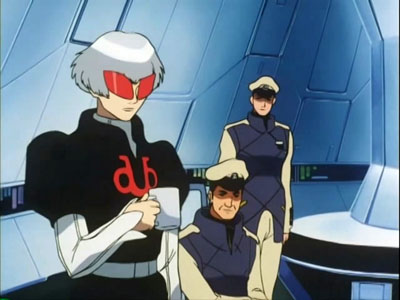
Coffee is universal, along with masked men
The shining point of the series comes somewhere in the second quarter with the development of Queen Dianna Soreil as a character, along with character interactions between Loran Cehack, Kihel Heim and Sochie Heim.
The desire of the queen of the moonrace for her people to return to Earth peacefully drives her character to lead with honour, and yet she is often powerless to stop the conflict’s expansion. Loran, a loyal moonrace who believes in the queen’s message of peace, nevertheless finds himself piloting a mobile suit and fighting against his own people on behalf of the local militia. His desire for the moonrace to return to Earth becomes anathema to his attachment to the Heim family who took him in when he first came to Earth.
There’s quite a fair bit of good material in there involving the four aforementioned characters and the second quarter of the series does a competent job covering it, if one overlooks the usual flaws. Interactions on a personal level between these characters generally make sense and produce the intended effects, if somewhat hampered by the poor directing and screenplay. I consider this to be the highlight of the series.
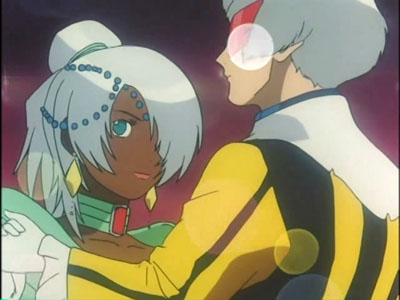
*wub*
However, all that is cast aside for most of the second half of the series where the story takes seemingly random detours that neglect and weaken the interesting character dynamics developed in the first half. This is so particularly in the last quarter where the story steadily descends into increasingly abstract discussions of war and free will, cumulating in a beautifully-animated mecha duel that somehow manages to be both symbolic (as a metaphor for the abstract concepts relating to war and human nature) and meaningless (in its relevance to the story leading up to that point) at the same time.
Towards the end, it becomes kind of hard to tell what all the major players are fighting for beyond some vague ideas of honour and hope, a stark contrast to the goal-driven political and physical conflicts depicted at the start of the series. Several illogical choices made by some of the characters also serve to undermine motivations developed previously over the course of the series. At times, it seems like things happen more or less for the lulz, or in this case dramatic effect.
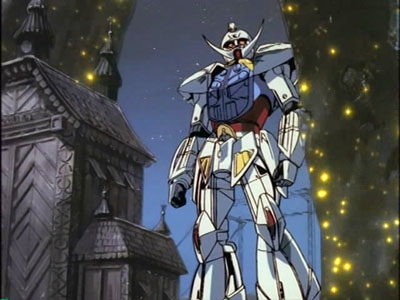
Girls have a thing for mustaches, right?
As a result, I consider the last quarter of the series to be one of the weaker parts of the story. It’s a good thing that Turn A decides to hastily revive the neglected relationships established earlier in the story for a Hail Mary emotional ending backed by the poignant vocals of Aki Okui, or it would’ve ended on a weak note without a timely reminder of the things it did right.
All in all, I can’t say that Turn A Gundam improved significantly in terms of storytelling from Gundam titles predating it. For a show made in the post-Eva era and coming from a production team that was by then highly experienced after two decades of Gundam, it falls short on many counts.
Still, it manages to present an entertaining and at times touching viewing experience which I found much superior to Tomino’s older works. (Here comes the flame.) A purge of unnecessary plot detours, a more sensible screenplay and a better ending would’ve probably landed it a spot in my top five. As it stands however, Turn A Gundam is a show I found enjoyable and intriguing, but not one I can recommend to everyone.
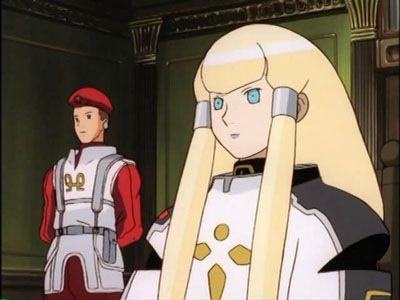
On a side note, it is unfortunate that Sunrise chose to employ some unconventional mechanical designs for this series. If it had used regular Gundam designs, or if it had not marketed the show as a Gundam title, Turn A would’ve been saved from a lot of unfair expectations and undue criticisms.

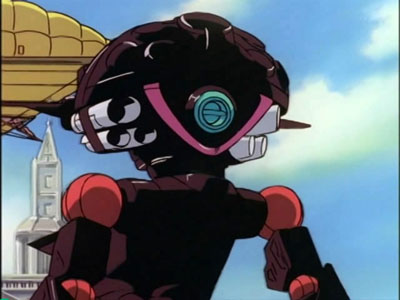
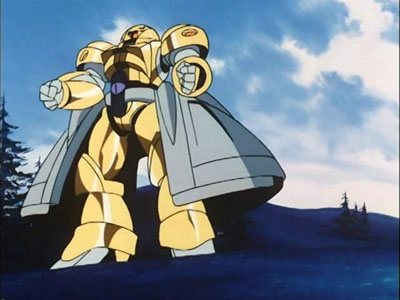
It’s wearing a skirt
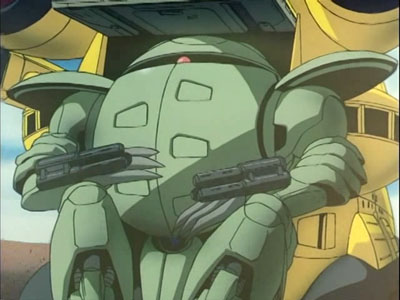
Okay, so I guess Gundam mecha designs have always been kind of whacky
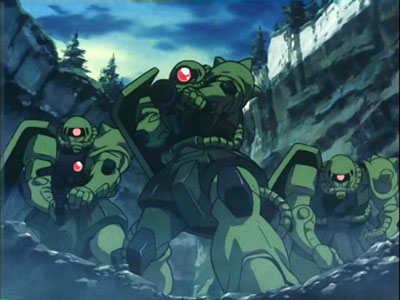
It’s different from a Zak…wait it’s not
Also, Queen Dianna was totally the prototype for Lacus Clyne.
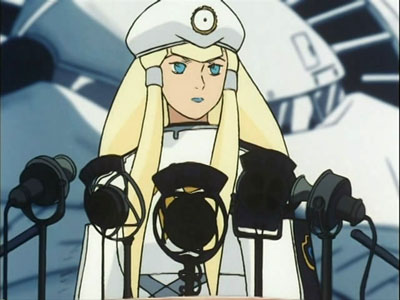
And now it’s time for me to return to hibernation.
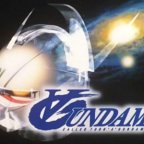






October 21st, 2009 at 7:15 pm
That’s pretty much my opinion on the title as well, including its strangely charming overall attributes that makes this my favorite Gundam show…
October 22nd, 2009 at 1:46 am
Why does Omo always arrive at Turn A posts before I do? What he said.
October 22nd, 2009 at 3:26 am
Turn A was most certainly unique. To me, it failed in the same way G00 did; good theme, poor execution.
Most of the Gundam shows from the late 1990s were rather unique, and were of a much different caliber than the past shows. 08th MS was my personal favorite from this era.
October 22nd, 2009 at 9:54 am
This Gundam was definitely unique. Mecha designs especially. But it’s also one of my favorite Gundams much for the same reasons Omo stated. Though it’s too bad Sochie didn’t have a consolation prize at the end. Kinda felt bad for her. And despite Loran’s questionable gender confusion with the enemy in the first half, he was a nice change from the usual emo Gundam pilot. And being the first and only “black” Gundam pilot so far, I’m a bit biased. ^_^;
October 22nd, 2009 at 11:29 am
I think Syd Mead did great work on Turn-A. Look at the gorgeous panel lines, and the lack of humongous backpacks. I also liked how Tomino turned the blue Capule into the green Kapool, thus spawning a new generation of amphibious mecha lovers beyond Acguy. Japanese fans did not like it, but the more discerning fans from the rest of the world welcomed the change. It kinda grows on you I suppose.
The show had some wacky fight direction too, which all fits given that most of the Earthrace started operating mobile suits on such a short notice.
Also, I don’t think those are anything but hands anymore ;_;
October 23rd, 2009 at 12:30 am
Loran wearing a gown w/ beads on her gray hair reminded me of Selvaria Bles of Valkyrie Chronicles.
October 25th, 2009 at 4:17 am
I remember being quite excited about the series after watching the first episode and this feeling remained for another 49. Very unique non U.C. Gundam incarnation (character + mecha design) which I recommend to everybody who enjoyed previous series.
Btw. Victory Gundam is my longest “running” series which I’ve started to watch almost 2 years ago but still haven’t finished it yet :) Not to mention After War Gundam X which is the last series I haven’t started to watch at all.
PS.: I love all OSTs for Turn A Gundam and if you can get your hands on them you will be definitely satisfied too :D
October 29th, 2009 at 1:13 pm
Wow Gundam! This is so classic, when I was in pre school i used to watch this a lot!
October 30th, 2009 at 4:17 am
When I was watching Gundam 00′s second season, there was this feeling of “hey we just abandoned down to earth reasons for greater ideals again like we did in Turn A”.
The problem is more of that the audience have gotten used to greater ideals going hand in hand with larger scale battles that are usually the climax of full length series for Gundam, and the people who are making it are afraid of trying anything else. Even when they do, they hit full throttle in no time to head back into it before the show ends. It’s like the whole motion detection without feedback in gaming, it just keeps coming back, where the hell is my cyberspace? >_>
It’s still awesome because of Loran though… mostly the cross dressing.
December 6th, 2009 at 10:23 pm
Sorry guys but i just prefer Macross and Evangelion from Gundam